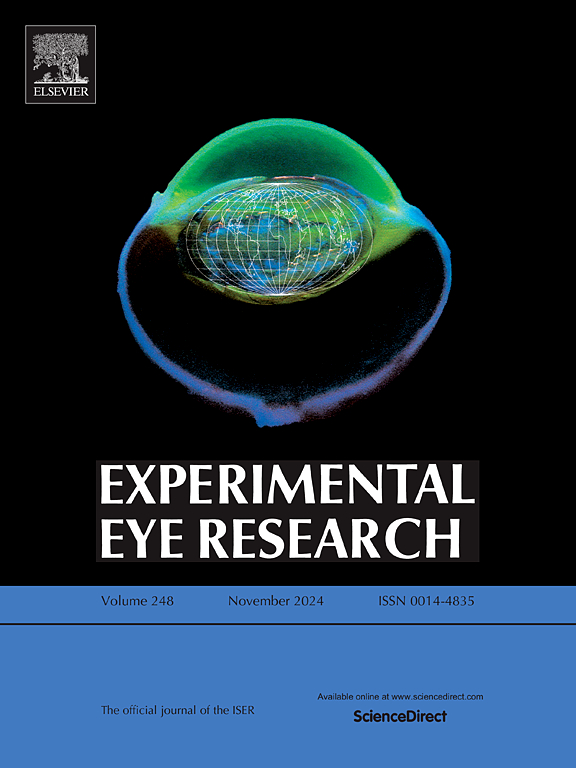在pde6b相关性视网膜色素变性中确定氧中毒/铁下垂的作用
IF 3
2区 医学
Q1 OPHTHALMOLOGY
引用次数: 0
摘要
遗传性视网膜疾病(IRDs)是一大类异质性疾病,可导致视力损害和完全视力丧失。色素性视网膜炎(RP)是一种伴有光感受器进行性变性的视网膜病变,与80多种基因突变有关。在这项研究中,我们研究了RP小鼠rd10模型中Pde6b基因遗传突变导致视网膜变性的机制,重点关注程序性细胞死亡的替代途径。以C57BL/6J小鼠为非变性遗传背景对照,采用RNA-seq分析方法鉴定rd10小鼠基因表达的变化。通过药物治疗研究差异表达基因的功能作用,并使用视动动力学跟踪法评估视力。我们发现参与炎症反应的基因表达增加,而参与光感受器功能和体内平衡的基因表达减少。我们还证明了调节氧中毒/铁下垂的基因表达增加,这是一种可以促进炎症反应的调节坏死。我们发现控制其他类型的受调节坏死的基因表达没有显著变化。用氧中毒/铁下垂抑制剂治疗rd10小鼠可显著改善其视力。因此,这些研究结果表明,Pde6b活性的破坏会通过氧中毒/铁下沉导致光感受器死亡,从而导致视网膜的炎症反应。我们的研究结果首次确定了催产素/铁下垂在遗传性视网膜变性模型中的可能作用,并为进一步研究催产素/铁下垂抑制剂作为RP的潜在治疗策略提供了基础。本文章由计算机程序翻译,如有差异,请以英文原文为准。
Identifying a role for oxytosis/ferroptosis in Pde6b-associated retinitis pigmentosa
Inherited retinal diseases (IRDs) are a large heterogeneous group of diseases that lead to visual impairment and complete vision loss. Retinitis pigmentosa (RP) is an IRD with progressive degeneration of photoreceptors and has been associated with mutations in over 80 genes. In this study, we investigated the mechanism of retinal degeneration caused by an inherited mutation in the Pde6b gene in the rd10 mouse model of RP, with a focus on alternative programmed cell death pathways. RNA-seq analysis was used to identify changes in gene expression in rd10 mice, using C57BL/6J mice as non-degenerating genetic background controls. The functional role of differentially expressed genes was investigated using pharmacological treatments and visual acuity was assessed using optomotor kinetic tracking assay. We found increased expression of genes involved in inflammatory response, while expression of genes involved in photoreceptor function and homeostasis were decreased. We also demonstrated increased expression of genes that regulate oxytosis/ferroptosis, a type of regulated necrosis that can promote inflammatory responses. We found no significant changes in expression of genes controlling other types of regulated necrosis. Treating rd10 mice with oxytosis/ferroptosis inhibitors led to significant improvements in visual acuity. Therefore, these findings suggest that disruption of Pde6b activity results in photoreceptor death via oxytosis/ferroptosis, contributing to inflammatory responses in the retina. Our results identify for the first time a possible role of oxytosis/ferroptosis in a model of inherited retinal degeneration and provide a foundation for further studies exploring oxytosis/ferroptosis inhibitors as a potential therapeutic strategy for RP.
求助全文
通过发布文献求助,成功后即可免费获取论文全文。
去求助
来源期刊

Experimental eye research
医学-眼科学
CiteScore
6.80
自引率
5.90%
发文量
323
审稿时长
66 days
期刊介绍:
The primary goal of Experimental Eye Research is to publish original research papers on all aspects of experimental biology of the eye and ocular tissues that seek to define the mechanisms of normal function and/or disease. Studies of ocular tissues that encompass the disciplines of cell biology, developmental biology, genetics, molecular biology, physiology, biochemistry, biophysics, immunology or microbiology are most welcomed. Manuscripts that are purely clinical or in a surgical area of ophthalmology are not appropriate for submission to Experimental Eye Research and if received will be returned without review.
 求助内容:
求助内容: 应助结果提醒方式:
应助结果提醒方式:


